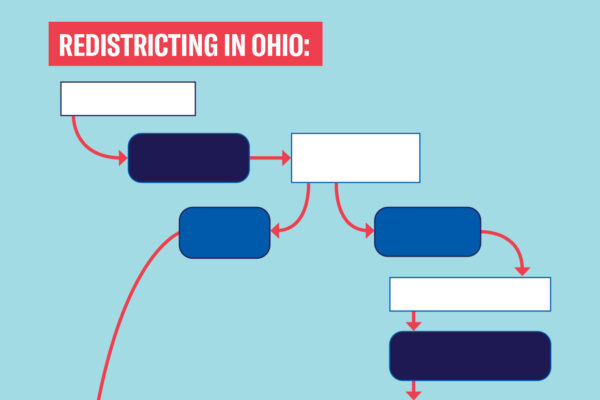2021 is a fresh start in many ways. It is the beginning of a new decade, the US appears to have turned the corner in the fight against COVID-19, and the current President’s twitter feed is pleasingly dull. History will mark the 2011-2020 era of American politics as plagued by polarization, during which we increasingly became the Divided States of America. Nowhere has this become more apparent than in the halls of Congress. But 2021 is a fresh start, and here in Ohio, that fresh start begins with a new way of drawing our Congressional districts. Out with the old, in with the new!
The process of redrawing legislative districts, known as redistricting, has historically been a partisan affair with a single political party in control of the state’s legislature drawing new districts to insulate their party’s incumbents from competitive elections. This may seem like just another maneuver in a political chess game, but manipulating districts to guarantee a preferred partisan outcome, aka gerrymandering, has very real consequences. Gerrymandering promotes partisan extremism, stifles legislative compromise, and dilutes the voting power of citizens. Is it any wonder the federal government can’t get anything done unless one party controls the White House, the Senate, and the House of Representatives? Unsurprisingly when that does occur, the minority party howls that it is the end of America as we know it.
So how do we fix this?
In order to bridge the gaps in American society, we need fairer, more representative districts, and the only way to do that is to reform the process by which we draw our districts. Fortunately, Ohioans passed two separate constitutional amendments in 2015 and 2018 to do just that. Read on below for highlights on Ohio’s redistricting reforms, with a spotlight on their strengths and weaknesses. And then be ready to be prepared for the political showdown of 2021.
So, here are the top 4 things you should know about redistricting:
- How We Got Here: Ohioans Demanded Change
Regardless of how you feel about the state government of Ohio, one positive we can all agree on is the mechanism for direct democracy enshrined in our state constitution. The people of Ohio, through a “citizens’ initiative,” can collect enough Ohioans’ signatures to put any proposal on the ballot for a simple yes or no vote of the people. Often times the citizen initiative is the last hope for concerned citizens when faced with a resistant legislature, as was the case for redistricting reform.
Back in 2015 and 2018, millions of Ohioans joined forces across the state, gathering signatures at coffee shops, football games, parades, and everything in between in order to place redistricting reform on the ballot. This drive and determination to change the way Ohio draws districts was palatable, and the ensuing public pressure forced the General Assembly to act. As a result, Ohio voters approved two different constitutional amendments designed to inject more fairness, bipartisanship, and transparency into the process for redrawing our state and congressional legislative districts. Over 70% of voters supported each of these measures, and more importantly, they supported the spirit of what these reforms sought
- What’s Next? New Rules for Drawing Districts
Take one look at Ohio’s Congressional district map, and you can see why Ohio needed to pass redistricting reform. Cartoonish districts with animal-themed names like Marcy Kaptur’s “Snake on the Lake” and Jim Jordan’s “Rubber Ducky” weave throughout Ohio with no rhyme or reason (other than these districts guarantee partisan outcomes before a single vote is cast). The lack of any sort of tangible rules or criteria allowed the previous Republican map drawers to create these knucklehead districts.
Ohio’s new redistricting process is an improvement from the old, because there are now some basic rules and criteria map drawers must follow. Restrictions on 1. the number of counties that can be split between districts, 2. limits on how many times a single county can be split (looking at you Cuyahoga and Summit), and 3. requiring (generally) large cities to remain whole (wink, wink Cincinnati) and districts to be compact. There are other new rules and guidelines, but these three get to the heart of what redistricting reformers want to achieve: less cracking and packing of communities and voters into predetermined districts. These new rules offer an objective standard for map drawers to adhere to and also give redistricting reform and voter rights advocates a concrete rule they can point to when evaluating proposed maps.
- Requires Transparency
Another new rule in place for this year’s round of redistricting is the requirement of transparency. This may seem mundane as you would think such a consequential process as redistricting would normally be conducted openly and in front of the public, but that has not been the case in Ohio. In previous redistricting cycles, maps were introduced and passed at breakneck speed. For example, HB 369, the legislation that created our current congressional districts, was introduced, voted on, and signed by the Governor all in less than 48 hours. That can’t happen again under the new transparency rules.
Under the new transparency rules, any proposed map is required to have multiple hearings before any action can be taken. During these hearings, citizens will be able to offer testimony on the maps and even submit their own maps for consideration. Additionally, for the first time ever, should map drawers fail to meet the new requirements for districts, it is mandatory that they include a written summary and explanation for their decisions. This public disclosure of map drawers’ reasoning and explanations for conforming (or not) to the new rules will be a valuable tool for voting rights advocates and redistricting reformers. Ultimately, these transparency requirements for the new map drawers will allow more Ohioans to contribute and participate in the process.
- Caution: We Can Still Get a Gerrymandered Map
The first three items on this list paint a rosy picture: Ohioans demanded change, so they created new rules and transparency requirements for map drawers to abide by, and now – the assumption is – that everything with be okay. Sadly, that’s not the case.
There is still plenty of potential for foul play during this process. The new rules are good, but they aren’t perfect. The transparency requirements are an improvement, but there will still be backroom deals. And ultimately, map drawers can still ram through a four-year gerrymandered map. To think that the new redistricting processes will inherently lead to fairer, more representative maps would be a mistake. It is going to take Ohioans from all across the state calling their legislators, writing letters to the editor, and engaging with their friends and neighbors to make sure we actually get the fair maps we were promised when voters went to the ballot box and rewrote our redistricting laws.
Complicating matters further is the news that the Census Bureau’s release of the data used to draw new maps will be significantly delayed. Typically, the states get census data by early April and thus have the entire summer and fall months to work on a new district plan, but this year, it doesn’t look like Ohio will receive its data until the end of September. This is problematic, because Ohio’s constitution sets September 1, 2021 as the deadline for state legislative maps to be created, with congressional maps by September 30. This puts Ohio between a rock and a hard place.
Attorney General Dave Yost recently sued the federal government in an effort to get census data by the traditional deadline of March 31. This is a misguided and dangerous approach to solving this issue. The Census Bureau delayed the release of their data in order to have enough time to conduct quality control checks and clean the data. By forcing the Census Bureau to still meet the March 31 deadline, we are greatly increasing the chances of using flawed data to guide map drawing. This means our maps will be inaccurate, and Ohioan’s voting power will be stifled once again. The ACLU of Ohio urges Attorney General Yost to rethink his lawsuit, work with the federal government, and come up with a plan for Ohio to receive accurate census data in a timely fashion.
For those interested in getting involved in the fight for fair districts, I encourage you to go to www.fairdistrictsohio.org/what-you-can-do. There you’ll find opportunities to participate in community mapping trainings, learn the ins and outs of Ohio’s new redistricting processes, request a speaker to talk about the importance of fair districts, and even sign up to become a speaker yourself. If you’re ready to get directly involved, visit Fair Districts: Ways to Get Involved. The ACLU of Ohio is also hosting a webinar title “Everything You Need to Know About Redistricting” on March 25th, where we’ll be taking a deep dive into our new redistricting process and hearing from experts about why fair maps are so important. Click here to register to attend!



